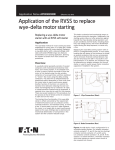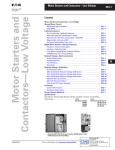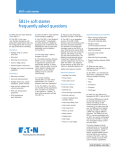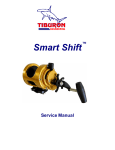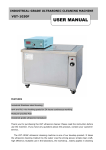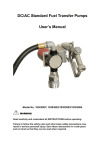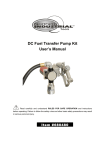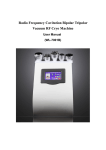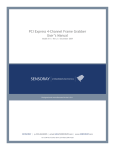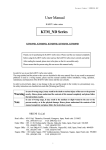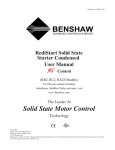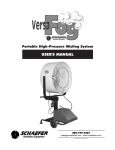Download Pump control option for S811+ soft starters for fluid pump
Transcript
Application Paper AP03902011E Effective February 2015 Pump control option for S811+ soft starters for fluid pump applications Application The pump control option is a factory-installed option designed to reduce or eliminate the potential for water hammer in a centrifugal pump system by utilizing a starting and stopping algorithm developed exclusively for pump control applications. Overview Surges or pressure transients occur in centrifugal pumping systems when any sudden change of flow is introduced. These surges can result from starting and/or stopping a pump, opening or closing valves, and many other sources in a particular system. There are a number of mechanical surge reduction techniques, but these tend to be costly and complex. Electronic starting and stopping of the pump motor is a cost-effective solution that reduces surges or hammering problems. Centrifugal pumps are generally coupled directly to the shaft of an electric motor. When applying full line voltage to start the motor, the pump is accelerated from zero speed to full speed very quickly. Less than 1/4 second is not uncommon. This means that the flow out of the pump also increases from zero to total capacity in less than 1/4 second. Due to the fact that fluids are only slightly compressible and have momentum, this large change in flow over such a short period of time results in high and low pressure surges and cavitations as the system seeks equilibrium. This results in many undesirable effects. Pressure surges stress the walls of the pipe and cause an audible noise. The sound is as if the pipe was struck with a mallet repeatedly. The noise is responsible for the term “water hammering” or just plain “hammering” being applied to this phenomenon. But the sound created is trivial when compared to the physical damage that pressure surges can cause. Extremely high-pressure transients can cause the pipe to burst while extremely low transients can cause pipes to collapse. Cavitations produce zones of highly agitated liquid and partial vacuums whereby the pipe lining may be eroded and the liquid may be boiled off. These effects also damage the valves and fittings. All of these effects are objectionable. Application Paper AP03902011E Pump control option for S811+ soft starters for fluid pump applications Effective February 2015 Starting and stopping the pump abruptly and subsequent rapid changes in flow cause the water hammer. Controlling the acceleration and deceleration of the pump motor can minimize this water hammer. To understand how the fluid flow is affected during the starting and stopping of a pump motor, a review of the various starting and stopping methods is necessary. The three methods of starting and stopping a pump motor to be reviewed are as follows: • Direct on line (closing a contactor and applying full voltage to the motor) • Solid-state reduced-voltage starting • Eaton soft starter controllers with pump control option Before comparing the three methods of starting, it is necessary to establish the relationship between the pumping system and the pump motor. Pumping system and pump motor relationship Change in fluid system pressure is directly proportional to change in motor torque because the centrifugal pump is directly coupled to the motor in most cases. Motor characteristics are described in terms of speed/torque curves. Fluid flow is proportional to speed (motor RPM), and pressure is proportional to torque, so we can directly compare the pump torque requirement and the motor torque curve. Direct on line starting (DOL) The motor torque output more than exceeds the requirement of the pump during the start cycle. Locked rotor torque (LRT) is the torque developed by the motor the instant that full voltage is seen at the motor terminals at zero speed. LRT can be as high as 180 percent of the torque the motor produces at full speed. Breakdown torque (BT) is the highest amount of torque the motor can develop. BT can be as high as 250 percent of full load torque. The difference between the torque produced by the motor and that required by the load is called accelerating torque. Accelerating torque is the torque that causes the motor to rotate the connected load. In the case of the pump, the excessive accelerating torque produced by starting the motor direct on line causes the pump to come up to speed very quickly, typically in less than 1/4 second. The result of this sudden change in speed (and therefore flow) is “surges” or “hammering” in the pipe system. Solid-state reduced-voltage starting (SSRV) The speed torque characteristics for DOL starting and solid-state reduced-voltage starting of an induction motor may be compared. With the SSRV starting method, the accelerating torque has been greatly reduced relative to the direct on line method of starting the pump motor. This is caused by the solid-state motor controller’s ability to start at a lower value of initial voltage and to “ramp” up to the full voltage value over an adjustable time period. The torque applied to the motor also “ramps” up. At the end of the “ramp,” however, there is a sudden and excessive acceleration torque, which generates a corresponding burst of speed (flow) at the end of the start cycle and also may result in hammering as the pump motor rapidly approaches 100 percent speed. This is a result of the breakdown torque that is still present when using a solid-state reduced-voltage starter. This sudden surge in pump motor torque at the end of the start cycle results in a flow surge. The sudden surge in torque is due to the characteristics of the motor. It occurs because solid-state reduced-voltage starting ramps the voltage up without regard to the motor’s performance. Solid-state reduced-voltage starting improves starting torque characteristics of the pump motor, but cannot control breakdown torque that causes surges. Eaton’s soft start controllers with pump control for starting pump motors Figure 1 compares direct on line starting, solid-state reduced-voltage, and pump control starting speed flow versus time curves. With pump control, the surge produced during DOL and solid-state reduced-voltage is greatly reduced. This is accomplished by using the microprocessor in the Eaton soft start controllers to carefully control the torque output to the motor. As there are no sudden changes in torque, this translates into a smooth acceleration of the motor, minimizing surges or hammering in the system. DOL Soft Start 100% Flow If the period of time in which the flow goes from zero to 100% can be increased, hammering can be reduced. This can be achieved by reducing the amount of accelerating torque delivered by the motor. Less accelerating torque means less force to turn the load and therefore more time required to change the speed of the pump. This can be done using a solid-state reduced-voltage starter to slowly ramp the voltage applied to the motor from zero to full voltage over some preset time (adjustable from 2 to 30 seconds). Time Figure 1. Starting Flow vs. Time 2 eaton corporation www.eaton.com Pump Control Pump control option for S811+ soft starters for fluid pump applications Application Paper AP03902011E Effective February 2015 hammering problems. In most applications, soft stop cannot prevent sudden changes in motor torque required on pumping applications. When a soft stop is initiated, the voltage is ramped from full voltage to zero volts over a time selected by the user (see soft stop in Figure 2). As shown before, reduction in voltage results in reduction of torque, and the pump begins to slow down. However, a point is quickly reached at which the load torque demand exceeds the motor torque supply, and the motor stalls. The effect, though not as severe, is the same as slamming a valve closed, and hammering occurs. Eaton soft starter controllers with pump control for stopping pump motors Stopping the pump is as critical in reducing surges and hammer as starting. In this discussion, we will limit the examples to speed (flow) versus time. Refer to Figure 2. When a direct on line starter is applied, the pump motor will coast when a stop command is initiated (see DOL coast stop in Figure 2). DOL Coast Stop The Eaton soft starter controllers with pump control option will control the deceleration of the pump motor in a method similar to the control of the acceleration. When a stop command is initiated, the controller reduces the motor speed to prevent any sudden changes in torque, minimizing surges in the system. The Eaton soft starter controllers continue to reduce the torque of the pump motor, resulting in a speed characteristic as illustrated in Figure 2. This type of pump motor deceleration curve results in minimal surges or hammering in the system, as there will not be sudden changes in flow. Soft Start 100% Pump Control Stop Flow Eaton soft starter controllers with pump control for starting and stopping pump motors To summarize, Figure 3 compares flow versus time when different starting/stopping techniques are employed. The Eaton soft starter controllers with pump control option produce the most desirable flow characteristics when starting and stopping centrifugal pump motors. There are no sudden peaks or breaks in flow that result in surges or hammering in the system. Stop Time When analyzing what is to be done about a hammering problem, an electrical solution should be considered before a mechanical solution. The initial cost for the electrical solution tends to be less than that of a specialized control valve, and less complex. In addition, the frequent maintenance/system shutdown that would be required with the specialized valve is not required with an electrical solution. Figure 2. Pump Stop Flow vs. Time The system head will quickly overcome the motor inertia, and the pump will come to a rapid stop. The fluid, which is in motion and has momentum, must come to a complete halt as well. This action causes pressure surges on the pipes and valves. This is undesirable due to the damage caused in the system. Eaton Electrical Services & Systems’ soft starter controllers with pump control option is the preferred starting and stopping method for centrifugal pump systems. Many control manufacturers are promoting a solid-state reducedvoltage starter with a soft or extended stop as a solution to surge or DOL Soft Start 100% Pump Control Pump Control Flow DOL Coast Start Run Soft Start Stop Figure 3. Pump Control vs. Flow eaton corporation www.eaton.com 3 Application Paper AP03902011E Pump control option for S811+ soft starters for fluid pump applications Effective February 2015 Supporting documentation Manuals Reference Number S811+ User Manual Program files Outline drawings MN03900001E None None Additional help In the event that additional help is needed, please contact the Technical Resource Center at 1-877-ETN-CARE, Option 2, Sub Option 2. Eaton Corporation Electrical Sector 1111 Superior Avenue Cleveland, OH 44114 USA Eaton.com © 2012 Eaton Corporation All Rights Reserved Printed in USA Publication No. AP03902011E / Z12532 February 2015 Eaton is a registered trademark of Eaton Corporation. All other trademarks are property of their respective owners.






